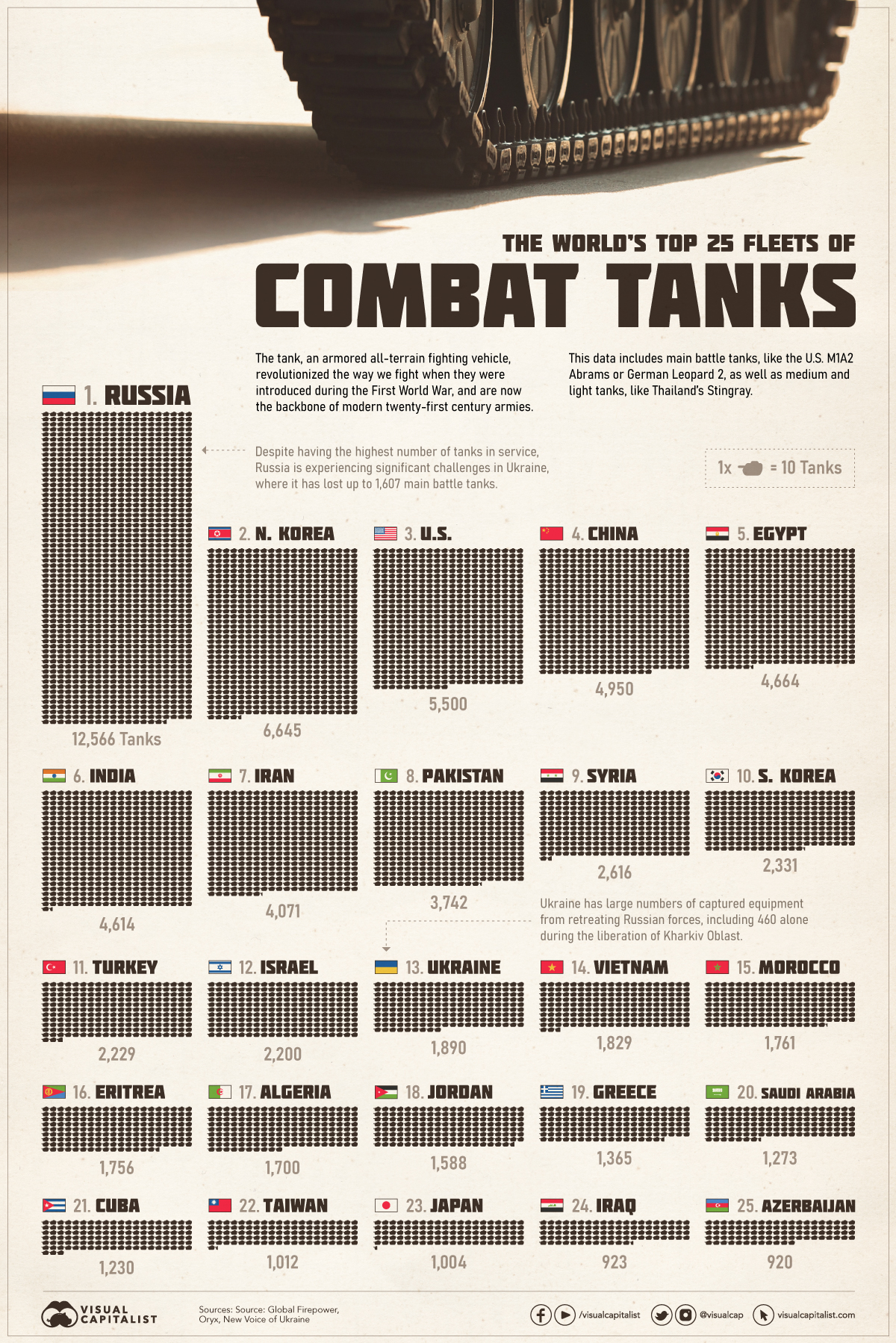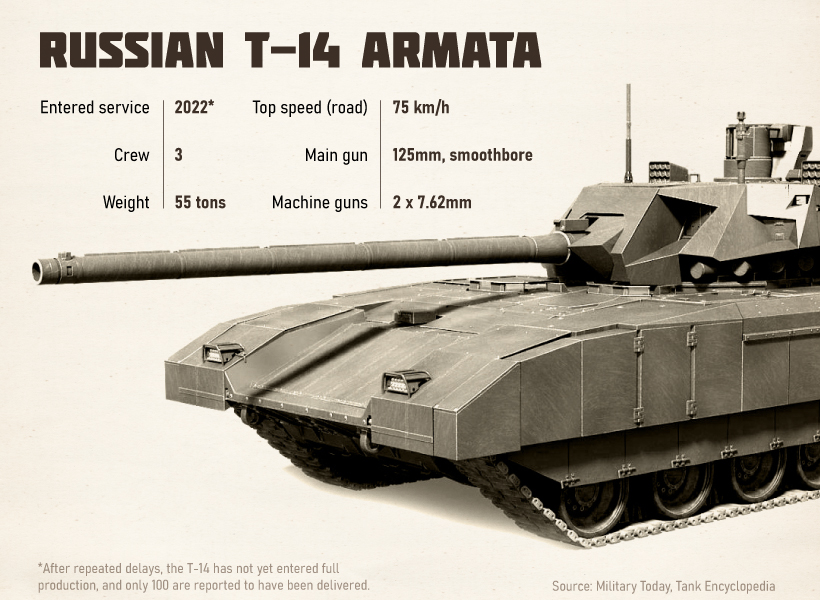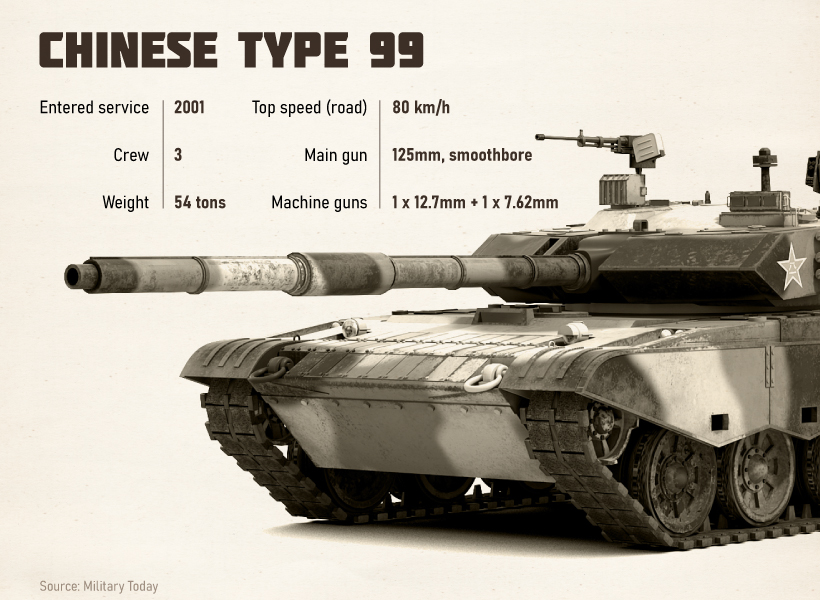
Can I share this graphic?Yes. Visualizations are free to share and post in their original form across the web—even for publishers. Please link back to this page and attribute Visual Capitalist.
When do I need a license?Licenses are required for some commercial uses, translations, or layout modifications. You can even whitelabel our visualizations. Explore your options.
Interested in this piece?Click here to license this visualization.
▼ Use This Visualizationa.bg-showmore-plg-link:hover,a.bg-showmore-plg-link:active,a.bg-showmore-plg-link:focus{color:#0071bb;}
Visualizing the World’s Top 25 Fleets of Combat Tanks
The tank, an armored all-terrain fighting vehicle, revolutionized the way we fight when introduced during the First World War. Since then, despite some commentators predicting the end of the tank era, they remain a cornerstone of 21st century armies.
Global Firepower has released their ranking of combat tank fleet sizes for 2023, which we’ve visualized in this infographic.
The ranking includes main battle tanks, like the U.S. M1A2 Abrams or the German Leopard 2, but also more lightly-armed medium and light tanks, like Thailand’s Stingray. The numbers do not include armored personnel carriers or infantry fighting vehicles.
Russia
Numbering 12,556 tanks, the Russian Federation has the largest fleet in their arsenal by far, from the workhorse T-72 series to the ultra-advanced T-14 Armata. This is more than the combined total of the number two and three spots, North Korea (6,645) and the U.S. (5,500).

But the headline number conceals a number of weaknesses of the Russian tank fleet.
Of Russia’s nearly 13,000 active combat tanks, only a fraction are main battle tanks. A 2021 Russian source estimated that their operational main battle fleet was closer to 2,600 tanks, made up of T-72s, T-80s, and T-90s, with another 400 T-72 variants used as range tanks.
On top of that, only one-quarter of those are considered modern tanks—T-72B3/B3M, T-80-BVM, and T-90A/M—that is, fitted with up-to-date fire control systems and sighting. That’s why, on top of poor morale, inadequate logistics, and inflexible tactics, Russia has struggled to perform on the Ukrainian battlefield despite having more than six times the number of tanks (12,556 vs. 1,890).
According to a Pentagon official speaking in early November 2022, Russia has lost half of their tanks since their so-called “special military operation” began on February 24, 2022. The conflict has also injured or killed thousands of civilians, displaced millions, and upended the post-Cold War security architecture.
North Korea
The world’s second-largest tank fleet belongs to North Korea, with a combat fleet of 6,645 tanks.
The Democratic People’s Republic of Korea has maintained armored capabilities since the Korean War (1950-1953) when their first armored unit, the 105th Armored Brigade, participated in the invasion of South Korea armed with 120 Soviet-made T-34/85 tanks.
After the war, the North Korean army rearmed with Soviet T-34/85s, and later with T-55s and Chinese-variant Type 59 tanks. Despite now being decades-old, these are likely still in service, alongside indigenous designs such as the Chonma-ho “Flying Horse” and the Pokpung-ho “Storm.”
Ultimately, these tank forces are considered to be no match for modern main battle tanks despite their numbers. One military blogger called them “weak and pathetic”—especially when compared to South Korea’s fourth-generation K2 Black Panther, considered one of the most advanced tanks in the world.
China
China’s People’s Liberation Army (PLA) recently accelerated fleet modernization plans at the 20th Party Congress, in anticipation of the army’s centenary in 2027, but they still have a ways to go.
Their fourth-place 4,950 combat tank fleet contains a mix of modern and obsolete tanks.
China’s most modern main battle tank, the third-generation Type 99, is a domestic design. Armed with a 125mm diameter main gun—slightly larger than the NATO standard 120mm—and 1,500hp diesel engine, it is tough and maneuverable. An upgraded variant, the Type 99A, debuted in the mid-2000s.

There is some speculation that the Type 99/99A could rival the U.S. M1 Abrams. However, it still falls short of fourth-generation designs, such as Russia’s T-14 Armata, South Korea’s K2 Black Panther, or Japan’s Type 10.
But thanks to a whopping $293 billion military budget, and significant industrial espionage, China’s defense industry is capable of producing military equipment at or near world-class standards, including tanks. The country even began testing unmanned tanks, including the Type 59 in 2018 and lightweight Type 15 in 2019.
Ukraine
Despite coming in at #13 with 1,890 tanks and initial predictions of a quick victory for Russian invaders, Ukrainian forces have successfully halted and then turned back their numerically superior foes.
Originally armed with upgraded Soviet-era T-64s, as well as donations of T-72s from Poland and Czechia, Ukraine’s tank forces have swelled thanks to captured military equipment left behind by fleeing Russian soldiers.
Oryx, a Dutch defense analysis website that has been tracking battlefield progress in Ukraine using open-source intelligence, estimates that 533 tanks, including several top-of-the-line T-90s, have been captured as of early 2023. According to a U.S. defense official, Ukraine may now have “more tanks in the battlefield than the Russians do.”
Arsenal of Democracy?
Looking ahead, Ukraine is asking for advanced Western main battle tanks, as it seeks to liberate the rest of its territory from Russia, including the Donbas and Crimea. NATO nations had been reluctant to take that step, as they were wary of further antagonizing Russia, but resistance seems to be diminishing.
On January 4, 2023, France agreed to deliver AMX-10 RC light tanks to Ukraine, the first Western country to do so. On January 6, the U.S. and Germany each agreed to deliver armored vehicles of their own, the Bradley and Marder, respectively.
And as another possible sign that the tide has turned, the UK has also said that it plans to donate a small number of Challenger 2 main battle tanks, while Poland has signaled their intention to donate Leopard 2 tanks (though the latter will need Germany’s permission to export).
As the spring campaign season approaches, we will see how these new weapons affect the balance of tank fleets both on and off the battlefield.
The post Visualizing the World’s Top 25 Fleets of Combat Tanks appeared first on Visual Capitalist.